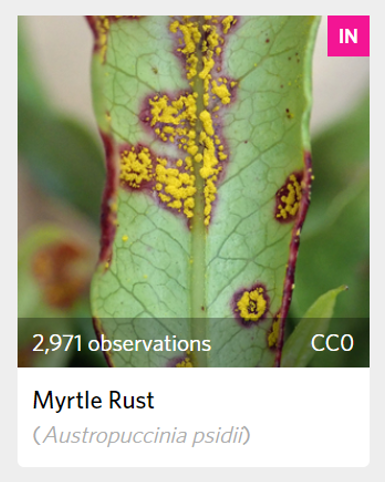Myrtle rust placed second as most reported fungus on iNaturalist NZ
Let’s start with the facts: as of 12 September 2023, 2,971 observations of myrtle rust (or rather Austropuccinia psidii, the fungus that causes myrtle rust) have been recorded on iNaturalist NZ, making it the second-most reported fungus here in Aotearoa. In first place is the introduced but classic-looking fly agaric (Amanita muscaria, a red-and-white mushroom) at 4,106 observations and in third place is our own native-to-New Zealand ear fungus (Auricularia cornea) at 2,607 observations.

Myrtle rust’s status on iNaturalist was known to Peter de Lange, a prominent iNaturalist user.
“My son was the first person to tell me this fact,” says Peter. “Apparently we also have the best records globally for myrtle rust observations as well.”
The iNaturalist NZ – Mātaki Taiao platform is a place where anyone can record what organisms they see in New Zealand, meet other nature watchers, and learn about Aotearoa's natural world. When Peter first heard about this tool, he was sceptical to say the least.
“I thought it was gimmicky and I didn’t want to have anything to do with it,” he says. “It was my son who got me interested. At the time he kept asking me ‘What’s this fungus dad?’ I thought, ‘Why don’t we just try this thing for fun’.”
Peter quickly went from sceptic to convert.
“I was very lucky that Dr Jerry Cooper from Manaaki Whenua—Landcare Research is very active on iNaturalist and very good at fungal determinations,” says Peter. “He put names to things we posted, which excited my son. And it got me kind of hooked.”
The iNaturalist app can be downloaded onto a phone. Users can upload several photos of the plant, animal, fungus or other organism they’d like to record and/or identify. It can be used to identify a wide variety of organisms, including A. psidii.
 Since there is no centralised, coordinated monitoring system for myrtle rust in New Zealand, iNaturalist has become a gathering place for myrtle rust researchers, biosecurity practitioners, government agencies, community groups, and gardeners to record infections. The nearly 3,000 records span from Northland to just south of Ōtautahi Christchurch and even the Chatham Islands.
Since there is no centralised, coordinated monitoring system for myrtle rust in New Zealand, iNaturalist has become a gathering place for myrtle rust researchers, biosecurity practitioners, government agencies, community groups, and gardeners to record infections. The nearly 3,000 records span from Northland to just south of Ōtautahi Christchurch and even the Chatham Islands.
Crowd sourced data can’t be used for everything, but it is useful nonetheless. So far, myrtle rust data has been used for mapping the extent of the disease and for sharing with a wide audience the spread of the disease to new locations and new host plants.
Last summer, for example, there was anecdotal evidence that pōhutukawa were being infected more frequently and more severely than they had in previous summers. The iNaturalist platform has been a great place to share and confirm the broader impact myrtle rust is having on pōhutukawa and other species like swamp maire and some of our climbing rātā species.
Peter suspects that iNaturalist will be valuable in tracking possible infections in kānuka and mānuka in the years to come.
“I know that these have the potential to become infected due to greenhouse inoculation trials,” he says. “And I do know that there have been a few observations of A. psidii on mānuka in the wild, but I have never seen myrtle rust on either kānuka or mānuka yet.”
Peter hopes that more people discover iNaturalist and record their observations of myrtle rust and of other organisms that might interest them.
“It’s like a cult,” says Peter, fondly. “You hear people whispering about it, and then you get on it and you think it’s quite useful. Then to your shock and horror you realize there are people who aren’t on it. And so you encourage them to join.”
Mahajabeen (Maj) Padamsee, programme leader for Beyond Myrtle Rust, is impressed and encouraged by the many myrtle rust observations made on iNaturalist.
“I think it just shows that people are really concerned when they do see a disease on myrtles,” says Maj. “It shows the power of community action and interest in monitoring for diseases and pathogens.”
- Jenny Leonard
